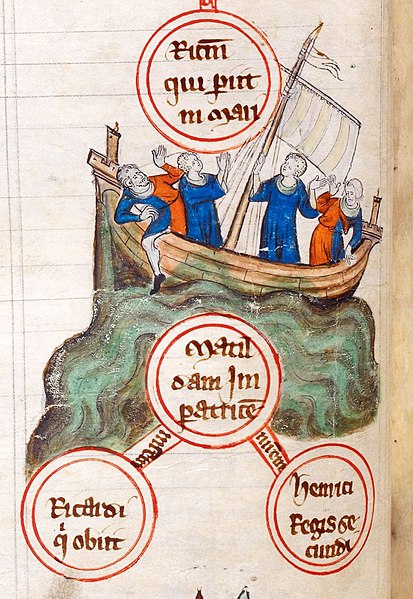Empress Matilda, also known as the Empress Maude, was one of the claimants to the English throne during the civil war known as the Anarchy. The daughter and heir of Henry I, king of England and ruler of Normandy, she went to Germany as a child when she was married to the future Holy Roman Emperor Henry V. She travelled with the emperor to Italy in 1116, was controversially crowned empress in St Peter's Basilica, and acted as the imperial regent in Italy. Matilda and Henry V had no children, and when he died in 1125, the imperial crown was claimed by his rival Lothair of Supplinburg.
12th-century depiction of Matilda and Henry's wedding feast
A 14th-century depiction of the White Ship sinking of 1120
Contemporary depiction of Geoffrey of Anjou, Matilda's second husband
A Matilda silver penny, minted in Oxford
The Anarchy was a civil war in England and Normandy between 1138 and 1153, which resulted in a widespread breakdown in law and order. The conflict was a war of succession precipitated by the accidental death of William Adelin who drowned in the White Ship disaster of 1120. Henry sought to be succeeded by his daughter, known as Empress Matilda, but was only partially successful in convincing the nobility to support her. On Henry's death in 1135, his nephew Stephen of Blois seized the throne, with the help of Stephen's brother Henry of Blois, who was the bishop of Winchester. Stephen's early reign saw fierce fighting with disloyal English barons, rebellious Welsh leaders, and Scottish invaders. Following a major rebellion in the south-west of England, Matilda invaded in 1139 with the help of her half-brother Robert of Gloucester.
Near contemporary illustration of the Battle of Lincoln; Stephen (fourth from the right) listens to Baldwin of Clare orating a battle speech (left)
Early 14th-century depiction of Henry I and the sinking of the White Ship off Barfleur in Normandy in 1120. British Library, London.
14th century depiction of King Stephen with a hunting bird
The keep at Goodrich in Herefordshire in the Welsh Marches, an example of the style of fortification slowly beginning to replace wooden motte and bailey castle designs by the late 1130s








